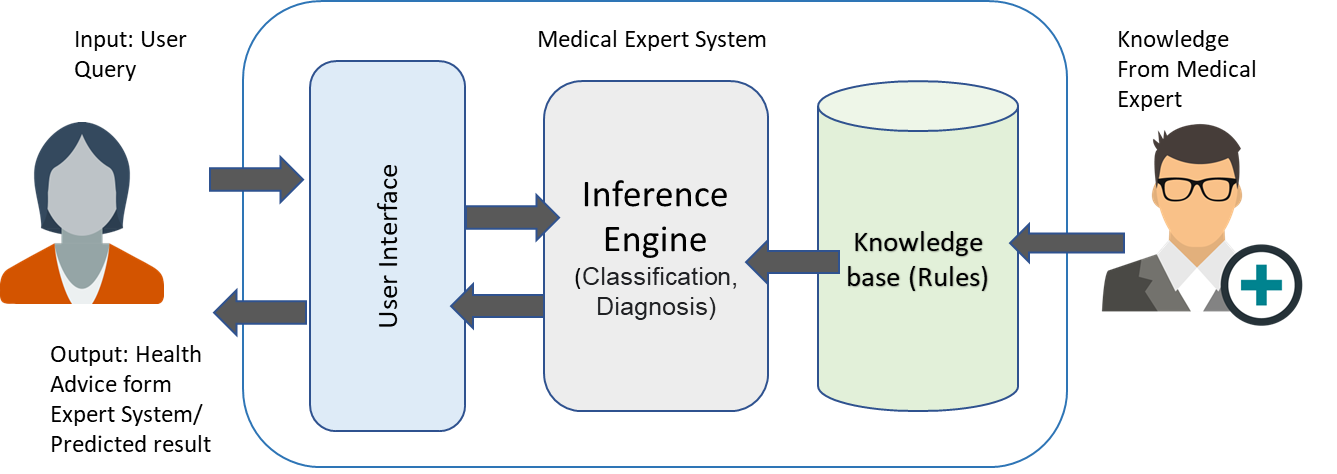Revolutionizing Healthcare: The Role of AI-Based Medical Expert Systems in Building a Better Future
Main Article Content
Abstract
Modern society has an increasing need for better architecture and medical care. However, this difficulty is not sufficiently addressed by present medical architecture. The Medicinal Expert technique can be used to help persons in need in order to address this issue. A tremendous amount of medical data, including patient medical histories, records, and new medications, can be managed and maintained using this technology. It can help with decision-making and fill in for specialists when they are not present. The Medicinal Expert approach is a complex computer software system that generates forecasts using empirical data and expert knowledge. Based on the available training data and knowledge base, these systems function intelligently. Additionally, there are numerous Medical Expert System tools that support clinicians, help with diagnosis, and are crucial for instructing medical students. In this study, we introduce an AI-based Medical Expert System, its features, and its potential to help patients and medical students. We also go through some key findings from recent and prior research on expert systems, as well as how these systems can make the world a better place.
Article Details
References
Sharma, A., Kumar, A., & Kumar, A. (2021). Heterogeneous ensemble forecasting model for COVID-19 cases: a case study of India. Neural Computing and Applications, 33(7), 2983-2992.
Singh, S., & Kaur, M. (2014). Effective heart disease prediction system using hybrid neuro-fuzzy approach. Procedia Computer Science, 48, 697-704.
Elngar, A., Saleh, A. I., & Gaber, T. (2021). An intelligent system for skin disease prediction using machine learning. Journal of Ambient Intelligence and Humanized Computing, 12(2), 1379-1391.
Subaeki, I. A., & Syafitri, U. D. (2017). Development of expert system for vertigo disease diagnosis. Procedia Computer Science, 124, 414-420.
Chebanenko, I., Kovalchuk, S., & Frolova, K. (2020). Data analysis and machine learning approach for patients' therapy optimization. International Journal of Advanced Science and Technology, 29(7), 6569-6580.
Muslim, M. A. (2018). Expert system for diagnosis of diseases using rule-based approach. International Journal of Engineering and Technology (UAE), 7(4.10), 369-372.
Goita, Y. (2021). Pandemic control: a multidimensional approach. Risk Management and Healthcare Policy, 14, 469-475.
Pallathadka, D. H. . (2021). Mining Restaurant Data to Assess Contributions and Margins Data . International Journal of New Practices in Management and Engineering, 10(03), 06–11. https://doi.org/10.17762/ijnpme.v10i03.128
Ahmad, S., & Khan, Z. (2017). Diagnostic decision support system of chronic kidney disease using support vector machine. International Journal of Computer Science and Mobile Computing, 6(4), 20-25.
Ananthi, R., & Deepa, R. (2017). Performance evaluation of categorized groups in predicting cardiac and renal effects of diabetes clinical data using fuzzy classification system. Health Information Science and Systems, 5(1), 6.
Inker, L. A., Levey, A. S., Tighiouart, H., & Eckfeldt, J. H. (2019). Novel biomarkers for the diagnosis of chronic kidney disease. Kidney International Reports, 4(5), 797-809.
Kotsiantis, S. B., Zaharakis, I. D., & Pintelas, P. E. (2006). Machine learning: a review of classification and combining techniques. Artificial intelligence review, 26(3), 159-190.
Zhang, L., Yang, M., & Zhou, X. (2017). A big data expert system with SVM-based classification for breast cancer diagnosis. Journal of medical systems, 41(7), 112.
Powers, D. M. (2011). Evaluation: from precision, recall and F-measure to ROC, informedness, markedness and correlation. Journal of machine learning technologies, 2(1), 37-63.
Quinlan, J. R. (1986). Induction of decision trees. Machine learning, 1(1), 81-106.
Aamir, M., Hussain, M., & Khan, I. (2019). Decision Tree Algorithms in Clinical Decision Support Systems. International Journal of Computer Applications, 182(40), 12-17.
Witten, I. H., Frank, E., & Hall, M. A. (2016). Data Mining: Practical machine learning tools and techniques. Morgan Kaufmann.
Wang, S., Summers, R. M. (2012). Machine learning and radiology. Medical Image Analysis, 16(5), 933-951.
Lipton, Z. C., Kale, D. C., Elkan, C., & Wetzel, R. (2015). Learning to diagnose with LSTM recurrent neural networks. arXiv preprint arXiv:1511.03677.
Hinton, G. (2012). Deep neural networks for acoustic modeling in speech recognition: The shared views of four research groups. IEEE Signal Processing Magazine, 29(6), 82-97.
KAUSHIL268. (2019). Disease Prediction Using Machine Learning, https://www.kaggle.com/datasets/kaushil268/disease-prediction-using-machine-learning

